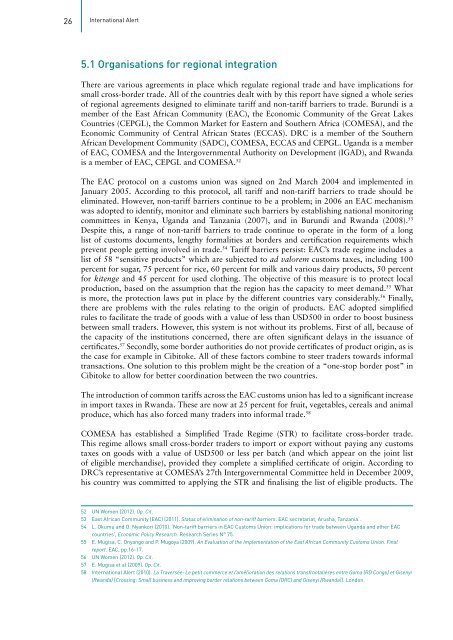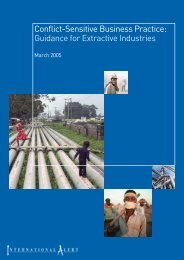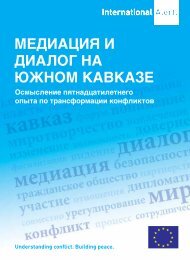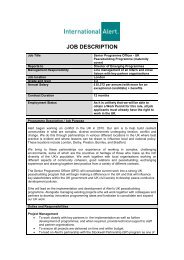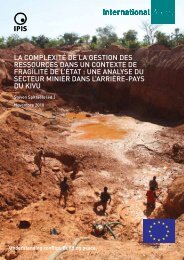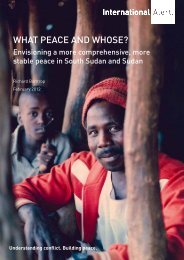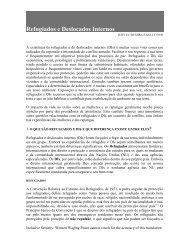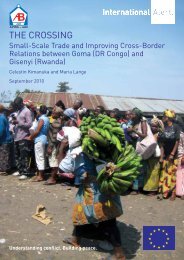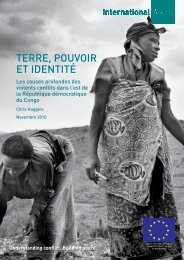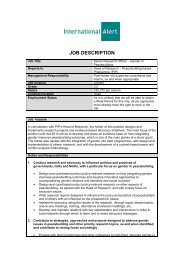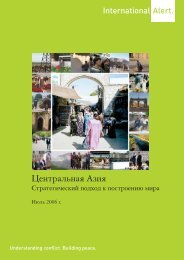Walking in the Dark: informal Cross-border trade ... - International Alert
Walking in the Dark: informal Cross-border trade ... - International Alert
Walking in the Dark: informal Cross-border trade ... - International Alert
Create successful ePaper yourself
Turn your PDF publications into a flip-book with our unique Google optimized e-Paper software.
26 <strong>International</strong> <strong>Alert</strong><br />
5.1 Organisations for regional <strong>in</strong>tegration<br />
There are various agreements <strong>in</strong> place which regulate regional <strong>trade</strong> and have implications for<br />
small cross-<strong>border</strong> <strong>trade</strong>. All of <strong>the</strong> countries dealt with by this report have signed a whole series<br />
of regional agreements designed to elim<strong>in</strong>ate tariff and non-tariff barriers to <strong>trade</strong>. Burundi is a<br />
member of <strong>the</strong> East African Community (EAC), <strong>the</strong> Economic Community of <strong>the</strong> Great Lakes<br />
Countries (CEPGL), <strong>the</strong> Common Market for Eastern and Sou<strong>the</strong>rn Africa (COMESA), and <strong>the</strong><br />
Economic Community of Central African States (ECCAS). DRC is a member of <strong>the</strong> Sou<strong>the</strong>rn<br />
African Development Community (SADC), COMESA, ECCAS and CEPGL. Uganda is a member<br />
of EAC, COMESA and <strong>the</strong> Intergovernmental Authority on Development (IGAD), and Rwanda<br />
is a member of EAC, CEPGL and COMESA. 52<br />
The EAC protocol on a customs union was signed on 2nd March 2004 and implemented <strong>in</strong><br />
January 2005. Accord<strong>in</strong>g to this protocol, all tariff and non-tariff barriers to <strong>trade</strong> should be<br />
elim<strong>in</strong>ated. However, non-tariff barriers cont<strong>in</strong>ue to be a problem; <strong>in</strong> 2006 an EAC mechanism<br />
was adopted to identify, monitor and elim<strong>in</strong>ate such barriers by establish<strong>in</strong>g national monitor<strong>in</strong>g<br />
committees <strong>in</strong> Kenya, Uganda and Tanzania (2007), and <strong>in</strong> Burundi and Rwanda (2008). 53<br />
Despite this, a range of non-tariff barriers to <strong>trade</strong> cont<strong>in</strong>ue to operate <strong>in</strong> <strong>the</strong> form of a long<br />
list of customs documents, lengthy formalities at <strong>border</strong>s and certification requirements which<br />
prevent people gett<strong>in</strong>g <strong>in</strong>volved <strong>in</strong> <strong>trade</strong>. 54 Tariff barriers persist: EAC’s <strong>trade</strong> regime <strong>in</strong>cludes a<br />
list of 58 “sensitive products” which are subjected to ad valorem customs taxes, <strong>in</strong>clud<strong>in</strong>g 100<br />
percent for sugar, 75 percent for rice, 60 percent for milk and various dairy products, 50 percent<br />
for kitenge and 45 percent for used cloth<strong>in</strong>g. The objective of this measure is to protect local<br />
production, based on <strong>the</strong> assumption that <strong>the</strong> region has <strong>the</strong> capacity to meet demand. 55 What<br />
is more, <strong>the</strong> protection laws put <strong>in</strong> place by <strong>the</strong> different countries vary considerably. 56 F<strong>in</strong>ally,<br />
<strong>the</strong>re are problems with <strong>the</strong> rules relat<strong>in</strong>g to <strong>the</strong> orig<strong>in</strong> of products. EAC adopted simplified<br />
rules to facilitate <strong>the</strong> <strong>trade</strong> of goods with a value of less than USD500 <strong>in</strong> order to boost bus<strong>in</strong>ess<br />
between small <strong>trade</strong>rs. However, this system is not without its problems. First of all, because of<br />
<strong>the</strong> capacity of <strong>the</strong> <strong>in</strong>stitutions concerned, <strong>the</strong>re are often significant delays <strong>in</strong> <strong>the</strong> issuance of<br />
certificates. 57 Secondly, some <strong>border</strong> authorities do not provide certificates of product orig<strong>in</strong>, as is<br />
<strong>the</strong> case for example <strong>in</strong> Cibitoke. All of <strong>the</strong>se factors comb<strong>in</strong>e to steer <strong>trade</strong>rs towards <strong>in</strong>formal<br />
transactions. One solution to this problem might be <strong>the</strong> creation of a “one-stop <strong>border</strong> post” <strong>in</strong><br />
Cibitoke to allow for better coord<strong>in</strong>ation between <strong>the</strong> two countries.<br />
The <strong>in</strong>troduction of common tariffs across <strong>the</strong> EAC customs union has led to a significant <strong>in</strong>crease<br />
<strong>in</strong> import taxes <strong>in</strong> Rwanda. These are now at 25 percent for fruit, vegetables, cereals and animal<br />
produce, which has also forced many <strong>trade</strong>rs <strong>in</strong>to <strong>in</strong>formal <strong>trade</strong>. 58<br />
COMESA has established a Simplified Trade Regime (STR) to facilitate cross-<strong>border</strong> <strong>trade</strong>.<br />
This regime allows small cross-<strong>border</strong> <strong>trade</strong>rs to import or export without pay<strong>in</strong>g any customs<br />
taxes on goods with a value of USD500 or less per batch (and which appear on <strong>the</strong> jo<strong>in</strong>t list<br />
of eligible merchandise), provided <strong>the</strong>y complete a simplified certificate of orig<strong>in</strong>. Accord<strong>in</strong>g to<br />
DRC’s representative at COMESA’s 27th Intergovernmental Committee held <strong>in</strong> December 2009,<br />
his country was committed to apply<strong>in</strong>g <strong>the</strong> STR and f<strong>in</strong>alis<strong>in</strong>g <strong>the</strong> list of eligible products. The<br />
52 UN Women (2012). Op. Cit.<br />
53 East African Community (EAC) (2011). Status of elim<strong>in</strong>ation of non-tariff barriers. EAC secretariat, Arusha, Tanzania..<br />
54 L. Okumu and O. Nyankori (2010). ‘Non-tariff barriers <strong>in</strong> EAC Customs Union: implications for <strong>trade</strong> between Uganda and o<strong>the</strong>r EAC<br />
countries’, Economic Policy Research. Research Series N° 75.<br />
55 E. Mugisa, C. Onyango and P. Mugoya (2009). An Evaluation of <strong>the</strong> Implementation of <strong>the</strong> East African Community Customs Union. F<strong>in</strong>al<br />
report. EAC, pp.16-17.<br />
56 UN Women (2012). Op. Cit.<br />
57 E. Mugisa et al (2009). Op. Cit.<br />
58 <strong>International</strong> <strong>Alert</strong> (2010). La Traversée: Le petit commerce et l’amélioration des relations transfrontalières entre Goma (RD Congo) et Gisenyi<br />
(Rwanda) [<strong>Cross</strong><strong>in</strong>g: Small bus<strong>in</strong>ess and improv<strong>in</strong>g <strong>border</strong> relations between Goma (DRC) and Gisenyi (Rwanda)]. London.


